Top News
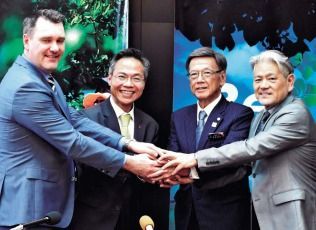
March 31, 2018 Ryukyu Shimpo
Okinawa Prefecture announced “The Caribbean of the East Initiative,” March 30, as part of a plan to make Okinawa into an East Asian cruise hub.
The initiative would develop a “Fly & Cruise” system that would make Okinawa into a location where travelers from all over the world would fly into Okinawa, the board cruise ships that would take them to the outlying islands in Okinawa and other locations in East Asia.
The prefecture is looking to establish themselves as a major port in Asia by attracting collaborators with economic partnership Memorandums of Understanding (MoU) with other major Asian ports such as Xiamen in China and Kaohsiung in Taiwan.
According to figures calculated for 2017, 515 ships visited ports in Okinawa, however only as a way-stop, meaning the increase in visitors did not translate to increased visitor spending.
If Okinawa were to become a departure point for ships, the time visitors spend as well as their consumption is expected to grow.
The initiative would develop a cruise industry departing from Okinawa that would link China, Southeast Asia, and the domestic ports of Japan.
Cruises that depart from hubs like Miami and make excursions around the Caribbean to location like Havana deploy state-of-the-art ships and have established process for CIQ (Customs, Immigration, and Quarantine), allowing them to commissions ships all over the globe.
Okinawa Governor Takeshi Onaga, who announced the initiative, said, “‘The Caribbean of the East’ initiative will spread interest globally, which will lead to additional cruise ports.
This will lead to investment in new terminals, and world-class resorts.”
The first step in the initiative in 2018 will be to strengthen PR for Okinawa to attract cruise-ship companies.
The second step in 2019 will be to sign MoUs with cities in China and Taiwan, to further attract cruise ships.
The initiative also looks to realize an Okinawa-based cruise industry that travels to the southwestern archipelago.
The third step in the initiative, from 2020 onward, will be to encourage private investment in Hirara Terminal and Shimojishima Airport to develop the “Fly & Cruise” strategy.
(English translation by T&CT and Sam Grieb)
Go to Japanese
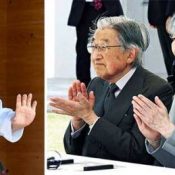
March 30, 2018 Ryukyu Shimpo
On March 29, the Emperor and Empress concluded their supposedly last official visit to Okinawa and flew back to Tokyo from Naha Airport with their special plane.
On the final day, they visited the Okinawa Karate Kaikan in Tomigusuku City.
Besides viewing Okinawa karate, the Emperor and Empress also learned about the history of Okinawa karate via display panels.
Four holders of Intangible Cultural Property recognized by Okinawa Prefecture demonstrated Okinawa karate katas at the special dojo outside the Okinawa Karate Kaikan. Following the demonstration, the Emperor and Empress spoke with each and every one of the performers.
They said, “Thank you very much for demonstrating such beautiful technique” and “Please take care.”
Morinobu Maeshiro, 73, who demonstrated the traditional useshi, said, “I was happy they could view the original form of karate that originated in Okinawa.”
Masahiro Nakamoto, 80, who demonstrated his mastery of nunchucks, smiled and said, “Opportunities like these may or may not happen once in a lifetime, so I am honored.”
The Emperor and Empress had stayed in Okinawa for two-nights and three-days from March 27.
They had visited the Japanese War Cemetery Okinawa, Okinawa Peace Memorial Hall, and Yonaguni Island.
According to a representative of Okinawa Prefecture, about 20,000 people welcomed the Emperor and Empress along their travel routes and destinations during the three days.
As Emperor, this was the sixth visit and 11th visit including the time when the Emperor was a Prince.
(English translation by T&CT and Chelsea Ashimine)
Go to Japanese
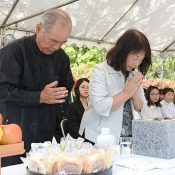
March 29, 2018 Ryukyu Shimpo
On March 28 at Shiratama no To, Tokashiki Village hosted a memorial service for those who died in the “collective suicide” (compulsory mass suicide) 73 years prior on March 28, 1945, during the Battle of Okinawa.
More than 100 bereaved family members and concerned persons attended. Attendees looked for names of their family members and friends on the stone slab, offered flowers nearby, and joined their hands in prayer.
Tokashiki Village’s mayor Yoshikatsu Matsumoto gave an address, saying, “Time flies like an arrow, 73 years have passed.
We must not forget the tragedy of the Battle of Okinawa.”
He then indicated his determination to pass down knowledge of this tragic history to the next generation.
Students of Tokashiki Elementary and Junior High School dedicated an art piece of folded paper cranes forming the character for “oath,” which indicates a vow of non-war.
Kanta Yamamoto, a second-year student from the Junior High School said, “We want to pass down stories we heard from survivors and through our peace studies,” and quietly prayed facing the stone slab.
Jitsui Makiya was the 5th mayor of Tokashiki Village and the head of an industrial association during the war.
He and his wife, Nahe, died in a group suicide. His daughter, 91-year-old Sachiko Miyagi from Ginowan City, traced the names of her parents engraved on the stone slab with her fingers, tearfully murmuring: “Dad, Mom.”
Miyagi was born on Tokashiki Island. She was mobilized to the Zuisen Student Corps during the war when she was 16 years old and living on Okinawa Island. It was after Japan’s defeat that she was informed of the death of her parents.
“Tears will not wither, no matter where on the island I look the tears flow. I will not let anyone have such experiences ever again,” she said with a grim look.
On March 27, 1945, the U.S. Army landed on Tokashiki Island.
The Japanese military ordered the residents to gather at Nishiyama at the northern part of the island.
On the 28th, displaced residents were cornered and forced to commit “collective suicide,” resulting in the death of 330 people.
(English translation by T&CT and Megumi Chibana)
Go to Japanese
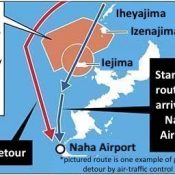
March 30, 2018 Ryukyu Shimpo
A 1985 agreement between the U.S. and Japanese governments gives civilian aircraft permission to enter U.S. military training airspace around Iejima at an altitude above 5000 feet (1524 meters). However on March 29 this year, the Marine Corps stated its understanding that passage of civilian aircraft is not permitted at all when the training airspace is in use by the U.S. military.
This is another indication that the U.S.-Japan Status of Forces Agreement (SOFA) is becoming merely a hollow shell.
There has been no mention of whether or not the agreement made in 1985 is valid. Domestic flights coming from outside Okinawa and arriving at Naha Airport have to detour around Iejima training airspace.
The U.S. Marine Corps stated that flights of civilian aircraft are not restricted when Iejima training airspace is not being used for military activities.
But it also expressed its understanding that if the airspace is in use, then passage cannot be permitted even above an altitude of 5000 feet and air-traffic controllers alert civilian aircraft in the vicinity that they must divert their courses.
At a House of Representatives Budget Committee meeting in March 1985, the director-general of the Civil Aviation Bureau of the Ministry of Transport (now the Ministry of Land, Infrastructure, Transport and Tourism) explained that they had reached an agreement with the U.S. that flights arriving in Naha were permitted through Iejima training airspace above an altitude of 5000 feet.
Up to this point civilian aircraft have passed through the Iejima training airspace safely above 5000 feet without hindering U.S. military activity, because the U.S. military normally conducts training at low altitudes in this airspace.
The Ministry of Transport explained in the National Diet that starting in April 1985 it would enforce this agreement.
According to aviation personnel, however, several years later flights were being restricted again.
Currently, entry into Iejima training airspace at up to an altitude of 15,000 feet is prohibited, so if the training area is in use, civilian aircraft coming to Naha from the north fly in accordance with air-traffic control’s instructions and detour all the way around this airspace. According to aviation personnel the government is normalizing this detour.
However, on March 28 an official from the Naha Airport Office of the Ministry of Land, Infrastructure, Transport and Tourism said, “Without the permission of the US and Japanese governments, I cannot say anything, including whether or not such an agreement exists.”
(English translation by T&CT and Erin Jones)
Go to Japanese
March 29, 2018 Ryukyu Shimpo
Tokyo – The U.S. military announced that the CV-22 Osprey scheduled to deploy from Yokota Air Base (Fussa City, Tokyo), will conduct nighttime flight training, air-to-surface firing training, and nighttime landing training in Okinawa.
While it was previously known that the CV-22 would be conducting air-to-surface firing and landing training in Okinawa, this was this first time it was announced that this training would also happen at night.
While the total flight hours for the CV-22 are at 74,000 hours relatively less than the MV-22, the per-100,000 flight hour Class A mishap rate is higher: 4.05% for the CV-22 compared to 3.24% for the MV-22
The Pentagon announced that the deployment of the CV-22 has been delayed to 2020.
The mishap rate for the MV-22 was revised to 3.24% this year, however in the past it was much higher.
The Japanese government indicated that the accident rate for these vehicles experience a downward trend from the moment they are deployed onward.
(English Translation by T&CT and Sam Grieb)
Go to Japanese
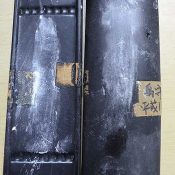
March 22, 2018 Ryukyu Shimpo
Seventy-nine year-old Isamu Kuniyoshi, who has collected remains from the victims of Battle of Okinawa for the past sixty years until he retired from collecting in March 2016, found a black pen case with the name “Masao Uema” inscribed.
The pen case was found among the numerous stored items at his home in Naha city.
Fifty-three year-old Yasuo Minamino from Naha city, who helped Kuniyoshi, noticed the pen case with a name while he was looking at the items at Kuniyoshi’s house on March 11.
Kuniyoshi and Minamino, “want to get it back to the owner,” and are seeking information from those who may know the owner.
Kuniyoshi has found bones from 3,800 bodies over the past sixty years, and has handed them over to the prefectural government.
He has also found 100,000 items including fountain pens, water bottles, rulers, and shoes, which he stores at his house in his, “War Materials Museum.”
He also returned items to owners and their families when the owners of the items are identified.
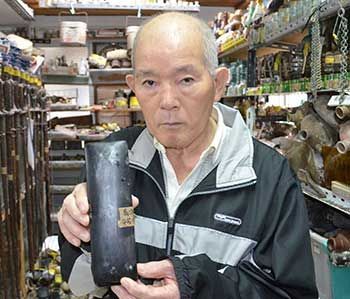
Isamu Kuniyoshi
The pen case that was confirmed to have the owner’s name is 20 centimeters in length, 6.5 centimeters in width, and 2.2 centimeters in height.
Kuniyoshi found the pen case when he was collecting remains around Shimamui Monument in Mabuni, Itoman City in 1999.
Kuniyoshi says, “[Returning the items to owners and families] is my hope,” and calls for information.
For questions and information, contact Minamino at 090-3840-9140.
(English translation by T&CT and Sayaka Sakuma)
Go to Japanese
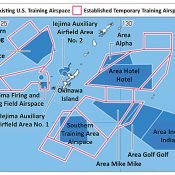
March 26, 2018 Ryukyu Shimpo
By Ryota Shimabukuro and Ryota Nakamura
Over the past two years U.S. military training airspace around Okinawa has greatly expanded, restricting the navigation of civilian aircraft.
The U.S. military added to its preexisting training airspaces in the form of temporary training airspaces under an Altitude Reservation (ALTRV) to be used as needed. In reality, the ALTRV airspaces became a constant provision to the U.S. military.
The preexisting U.S. military training airspace is mostly contained within the temporary airspace.
According to aviation personnel, almost every day the U.S. military claims official use of ALTRV airspace, and the passage of civilian aircraft is restricted.
However, because the U.S. military sought these training airspaces under the guise of being “temporary,” the scope of the airspaces were not indicated on charts provided to the Okinawa Prefectural Government and other bodies.
It appears that the scope of airspace actually used for U.S. military training is about 60 percent larger than the airspace designated for U.S. military training.
The Ministry of Land, Infrastructure, Transport and Tourism (MLIT) established the ALTRV airspaces under the pretense that they were for use by the Japan Self-Defense Forces (SDF). Initially, the Air Self-Defense Force (ASDF) denied that the U.S. military would use the ALTRV airspaces.
Later the ASDF admitted the airspaces were for joint use with the U.S. military, and that it was not at liberty to discuss whether the U.S. military was using the airspaces independently.
According to several persons involved in aviation, the U.S. military is using these airspaces on a daily basis.
These ALTRV airspaces were established in December 2015.
The U.S. military has established ALTRVs in the past, but it is unusual for it to establish such an expansive ALTRV to the extent that it encompasses preexisting training airspace.
In Kadena Air Base’s Range Planning and Operations documents released on December 28, 2016, its review of training airspace in Okinawa described the airspaces being used by the U.S. military as a “Stationary ALTRV.”
Kadena Air Base authorities acknowledged that the airspaces were established under an ALTRV, but in terms of the frequency of their use, stated that due to security-related reasons it could not disclose particulars about training.
The base’s authorities also claimed that due to the U.S.-Japan Status of Forces Agreement, they could not comment on the timeframe or contents of the training airspace review mentioned in base documents.
However, U.S. military activity in the temporary training airspaces and the timeframe of such use is specified in the aviation data referenced by air-traffic control personnel and pilots.
When the MLIT, which manages airspace, was asked if the U.S. military was using the temporary airspaces, it mentioned not fully knowing the situation.
However, it later corrected its comment for the media, stating that the U.S. military has permission to use the ALTRV airspaces.
The MLIT stated that what it meant is that it does not fully know who is in the airspace or their activities.
An official of the MLIT said, “We have received appeals from civil aviation personnel, asking for reduction of training airspace for the purpose of flight safety. That would be a move in the opposite direction.”
(English translation by T&CT and Erin Jones)
Go to Japanese
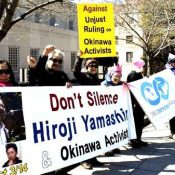
March 25, 2018 Ryukyu Shimpo
By Washington Special Correspondent Yukiyo Zaha
Washington – The Coalition Against U.S. Foreign Military Bases, which is based in the U.S. and composed of various peace and environmental protection groups, staged a demonstration in front of the Japanese Embassy in Washington D.C. calling for the reversal of a guilty verdict handed down to Hiroji Yamashiro, head of the Okinawa Peace Action Center, who was given a suspended sentence for “forcible obstruction of business,” from his protests against new base construction in Henoko, Nago.
The demonstration protested against the new base construction as well.
The demonstration included 15 protesters from groups including Okinawa Peace Appeal, a citizens group of Okinawans living in America, Veterans for Peace (VFP), made up of ex-military members, and CODEPINK, a female-centered peace group.
The group protested carrying signs that read messages such as, “Close the Bases!” and “We will not be silenced!”
The protest letter submitted to the Japanese Ambassador to the U.S. said of the Yamashiro cases’ verdict, “It is a sign of repression by the authority against the anti-bases movement by intimidating and putting pressure on the people not to join the activities by showing them the risk of the arrest and indictment.
It attempts to hide the true crime of progressing militarization, despite the fact that it destroys the environment, ignores the democratic will of Okinawan people, and the base puts their lives in danger.
Bahman Azad, the representative for the Coalition, said, “Increased crime and accidents caused by the existence of these bases is a worldwide problem.
This verdict will not silence us, but further the movement and lead us to the next step.”
(English translaton by T&CT and Sam Grieb)
Go to Japanese
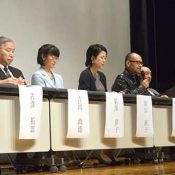
March 22, 2018 Ryukyu Shimpo
On March 22 at the Okinawa Prefectural Museum in Naha City, the Japanese Society for Oceanic Studies held a public symposium.
Professor Yasukatsu Matsushima of Ryukoku University reported that many human remains were removed from Okinawa by anthropologists from this former imperial university in the early Showa era, and were not returned.
Matsushima made a request for the remains to be returned, and made known once more that he plans to bring a class action lawsuit against Kyoto University, which keeps the remains.
Matsushima said, “Grave robbery is a criminal offense under criminal law, and storing stolen goods is complicity.”
He criticized that, “It is an injustice that the remains of the ancestors who built the foundation of the Ryukyu Kingdom were not buried or given service for the repose of souls in the manner of the Ryukyuan people.”
Moreover, he requested their return and emphasized that, “By receiving proper burial, the remains revert from being objects to being the souls of people. Their relationship with the living world will be restored. This would be a political symbol for decolonization.”
Associate Professor Naoko Fukayama at Tokyo Metropolitan University, who is researching the indigenous Maori of New Zealand, said, “Okinawa and Oceania have commonalties, in that they were subjected to colonialism. Oceanic studies can contribute to Okinawa in many ways thorough observing how residents talk about their culture and keep it alive.”
Masanori Yoshioka, a visiting professor at the Open University of Japan’s Hyogo Study Center, pointed out that the problem is that Oceania is still seen as a “frontier.” He suggested that, “By focusing on elites such as Hilda Lini, a leader of cultural revival in Vanuatu, we will be able to understand [Oceania] as the fusion of tradition and modernity.”
(English translation by T&CT and Megumi Chibana)
Go to Japanese
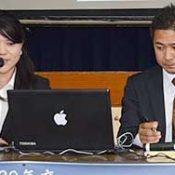
March 11, 2018 Ryukyu Shimpo
On March 15, the 2017 World Ginozanchu Exchange Program Presentation was held at the Ginoza Village Public Hall where approximately 80 people gathered. Hibiki Yasutomi, 27, and Lania Shinzato Hinako, 22, who traveled to South America and Hawaii as trainees reported on their findings.
The exchange program was established in 2006, making this the 12th gathering.
The trainees traveled to places where people from Ginoza Village emigrated to, such as Argentina, Peru, Brazil, and Hawaii.
The aim of the program is to establish and reaffirm one’s identity as Ginozanchu via cultural exchange with local emigrants from Ginoza Village or the second and third generations.
The training was approximately a month starting January 4.
Yasutomi said, “I was surprised at how Okinawan culture, such as the sanshin and shimakutsuba, had been passed on to the immigration destinations.”
Lania said, “I was impressed by the emigrants who established their own place in an unknown land.”
Village Mayor Atsushi Touma said, “The two trainees have a huge role, which is to pass on what they felt and learned abroad. I hope they apply what they’ve learned from their experiences to the future.”
(English translation by T&CT and Chelsea Ashimine)
Go to Japanese
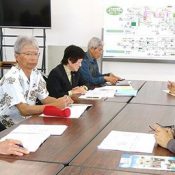
March 18, 2018 Ryukyu Shimpo
On March 16, a group of Nakagusuku Village and Kitanakagusuku Village residents who oppose collecting waste from the U.S. bases visited the Aobaen waste processing facility operated by Nakagusuku Village and Kitanakagusuku Village Sanitation Affairs Association.
The residents’ group submitted a letter of appeal to the head of the Association Kiyoshi Gima, asking that the Association stop collecting U.S. military waste come April. In addition, the group submitted an open letter of inquiry about the contents of the U.S. military waste collected.
Following the revocation of Kurashiki Kankyo Company’s license for waste disposal, including industrial waste, the Nakagusuku Village and Kitanakagusuku Village Sanitation Affairs Association has been collecting up to four tons of general waste per day from U.S. military facilities since December last year.
The Association has decided to continue collections into April.
At the time when the Aobaen waste processing facility was constructed, it was subsidized by Japan’s former Defense Facilities Administration Agency.
The villagers’ letter of appeal contains five points, including a request for the release of memos and communiqué exchanged between the U.S. military in Okinawa and the Okinawa Defense Bureau during construction of the Aobaen facility, and a request for the villagers’ opinions to be heard.
The residents’ group stated that the lack of an advance notice to residents about collection shows that these matters were handled dishonestly without villagers’ involvement. Also, they complained that, “U.S. military waste contains toxic substances, so we are worried that these facilities will not be usable later.”
Furthermore, the residents’ group composed a questionnaire of five inquiries, one of which asked for disclosure of the basis whereon waste disposal companies in the villages began collecting U.S. military waste, dispite the fact that the 2014 waste management plan for Kitanakagusuku Village did not contain even a hypothetical mention about the disposal of U.S. military waste.
Gima of the Sanitation Affairs Association said that collecting U.S. military waste does not pose any particular problem.
As for the questionnaire from the villagers, he simply said, “I hope to answer scrupulously.”
(English translation by T&CT and Erin Jones)
Go to Japanese











 Webcam(Kokusai Street)
Webcam(Kokusai Street)


